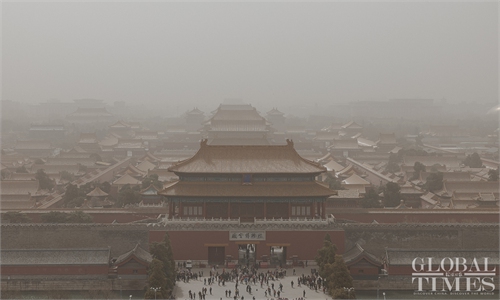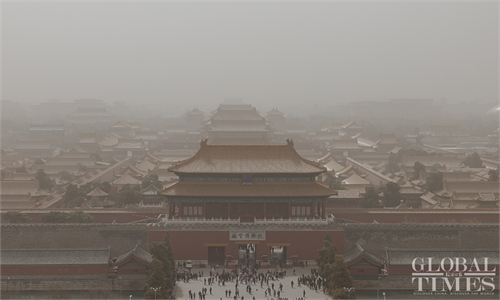Northern China to encounter its 10th dusty weather this year; experts call for international cooperation in dusty weather control

People in Hohhot, North China’s Inner Mongolia Autonomous Region wrap scarves around their heads as the city is engulfed in sandstorms on April 10, 2023. Photo: IC
Sand and dust are expected to blanket a vast area in the northern part of China this coming weekend, the 10th dusty weather period this year, with some places expected to suffer from strong sandstorms, against which experts suggested international cooperation in dusty weather control.
China’s Central Meteorological Observatory continued to issue a blue warning for sandstorm on Wednesday morning, with a vast area across China from Northwest China’s Xinjiang, the capital Beijing to Northeast China’s Jilin Province expected to suffer from sandy and dusty weather due to the influence of cold fronts. Some areas such as Tarim Basin in Xinjiang, western part of North China’s Inner Mongolia Autonomous Region and the Hexi Corridor in Northwest China’s Gansu Province are even expected to be hit by strong sandstorms.
In addition to sandstorms in the northern part of the country, this round of cold front will also bring major temperature drop and rainfalls in central and eastern part of China. It is expected that the cold front will bring a big drop in temperature in most parts of China from April 18 to 23, with temperatures in many places dropping by more than 25 degrees.
This will constitute the 10th round of dusty weather to hit China since the beginning of this year, the most over the past decade during the same period, with a vast area of the country being affected.
Meteorologists have predicted that the dusty weather in the Beijing-Tianjin-Hebei region and its surrounding areas as well as in the regions in the Northeast China will gradually improve in the coming week due to the better regional atmospheric diffusion conditions, but the sand and dust will linger in Northwest China and Inner Mongolia areas.
Experts have attributed the more frequent sand and dust weather in Northern China this year to multiple factors including stronger winds generated by cold fronts, higher temperatures and poor vegetation coverage in the southern parts of Mongolia and northern China due to lower precipitation.
However, monitoring data from China’s National Forestry and Grassland Administration shows that China currently now encounters less sand and dust weather compared with decades ago.
The number of dusty weather periods between March and May decreased over the past two decades and dropped to an annual average of 8.4 rounds over the past decade from the annual average of 20.9 rounds in the 1960s. Despite frequent dusty weather occurrences this year compared with the previous years, the number remains in a normal fluctuation range.
According to Ma Jun, director of the Institute of Public and Environmental Affairs (IPE), a Beijing-based non-profit environmental organization, in terms of sand and dust prevention and control, shelterbelts should be planted for a long term for windbreak and sand fixation.
Meanwhile, human disturbance to land in dry and vulnerable areas should be avoided, excessive reclamation of agriculture and animal husbandry should be reduced, and vegetation restoration should be encouraged in mining, Ma told the Global Times on Wednesday.
After the Three-North Shelter Forest Program was launched, the frequency of sandstorms in China has been decreasing since 2000, but the frequency of sandstorms in the past few years has shown a resurgence.
Official data showed that the two strongest dusty weather periods of March 19 to 23, and April 9 to 13 this year that hit a vast range of area covering more than a dozen provinces and regions across China, both originated mainly in Mongolia, according to China's National Meteorological Center (NMC).
According to Ma, Mongolia is facing ecological problems caused by overgrazing and mining, and international cooperation should be facilitated in the future to help these areas restore their natural ecology.
Gui Hailin, chief forecaster from China’s Central Meteorological Observatory, also noted that sandstorms are an “international” phenomenon that transcends national boundaries and requires not only the governance from China but also international cooperation.



